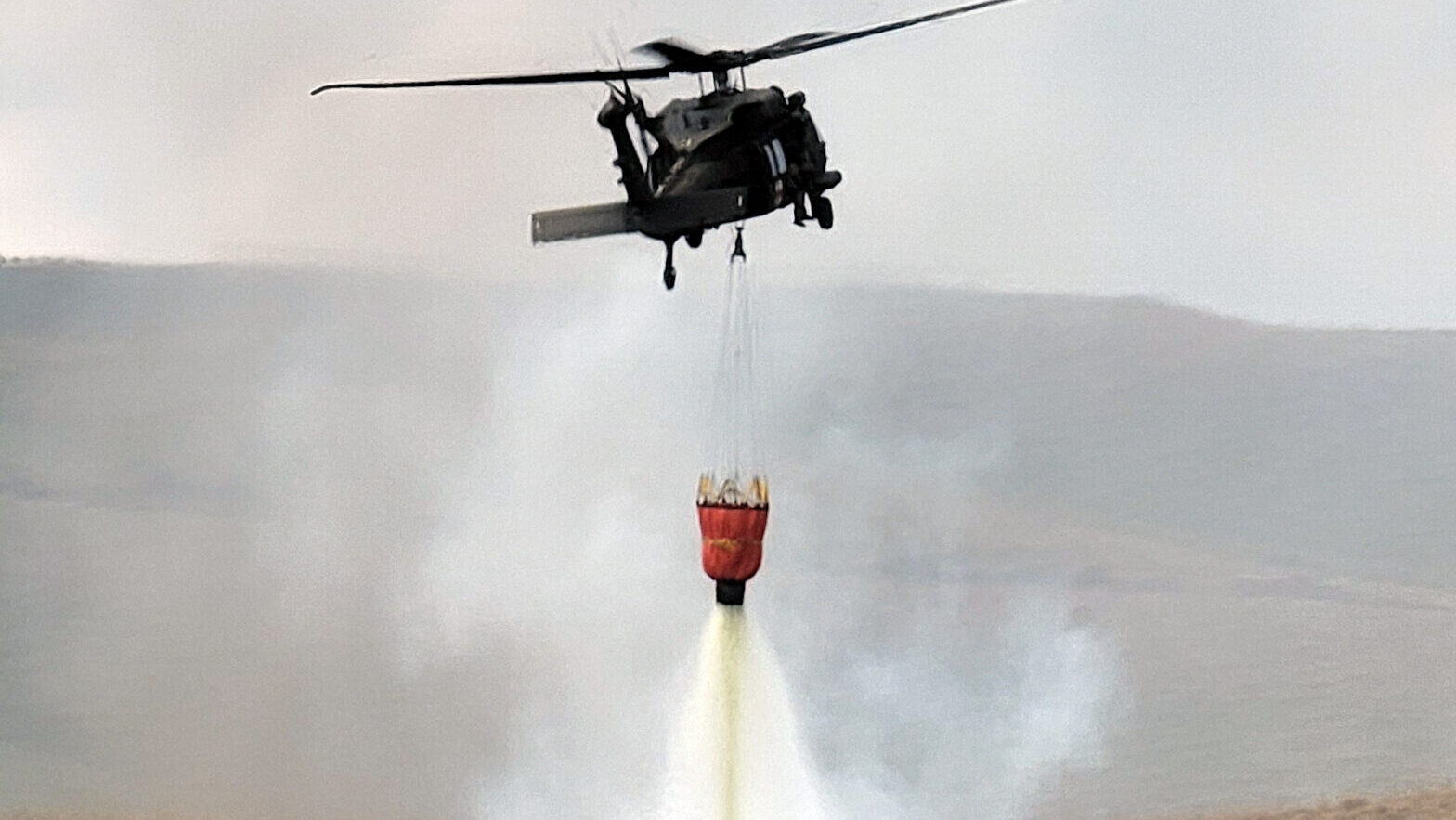
U.S. Army HH-60 Black Hawk pilots and flight crew assigned to the 25th Infantry Division, help local firefighters extinguish a fire using a Bambi bucket near the Pohakuloa Training Area, Hawaii, July 31, 2021. (Capt. Ryan DeBooy/US Army)
WASHINGTON: The US Army wants to field an all-electric, non-tactical vehicle fleet and install microgrids on every installation over the next 13 years, according to the service’s climate strategy.
The Army’s climate plan, published Tuesday, aims to increase the service’s preparedness for operating in harsher environments caused by climate change, while reducing the service’s own contribution to the ecological crisis through greenhouse gas emissions. The strategy states that the service wants to be a “resilient and sustainable” land force.
“The time to address climate change is now,” Army Secretary Christine Wormuth wrote in the strategy’s foreword. “The effects of climate change have taken a toll on supply chains, damaged our infrastructure, and increased risks to Army Soldiers and families due to natural disasters and extreme weather. The Army must adapt across our entire enterprise and purposefully pursue greenhouse gas mitigation strategies to reduce climate risks.”
Under the climate strategy, the Army aims to achieve a 50% reduction in its net greenhouse gas emissions by 2030 from its emissions in 2005, while ultimately achieving net-zero emissions by 2050. The service will also “proactively consider” the security implications of changing climates in strategy, planning, supply chain, acquisition and programming documents, the strategy said.
The strategy lays out three lines of effort, each with a number of underlying objectives. The first is installations, where the service wants to adapt infrastructure to improve resiliency and sustainability. That includes the installation of a microgrid on every installation by 2035. As for vehicles mostly driven at or between installations, the Army plans to field an all-electric light-duty non-tactical vehicle fleet by 2027, while aiming for an all-electric non-tactical fleet overall by 2035. By 2040, the service wants to attain on-site carbon pollution-free power generation for critical missions for its more than 130 installations.
“Going forward, the Army will actively pursue carbon-pollution-free electricity production and storage to and on its installations,” the strategy states. “The Army looks to its real property assets to continue providing space for new renewable energy projects that both reduce GHG emissions and increase energy resilience.”
Second, acquisition and logistics line of effort will work to improve the service’s carbon footprint by investing in electrification, using predictive logistics, procuring green technologies and bolstering the climate resilience of its supply chain.
Under the logistics line of effort, the service wants to field purpose-built hybrid-drive tactical vehicles by 2035 and fully electric tactical vehicles by 2050. One problem the Army faces in that is that fully-electric tactical vehicles are a challenge on the battlefield because its difficult to bring chargers far forward. Under the strategy, the service plans to develop a charging capability for tactical EVs by 2050.
The Army will also institute a “Buy Clean” policy for procurement of construction materials, the strategy states, in order to reach net-zero greenhouse gas emissions by 2050.
“It is time to ask Army suppliers to further reduce both embodied emissions and the impact that supply chain activities have on the climate,” the strategy states.
Under the strategy’s final line of effort centers on training soldiers to prepare them for harsher environments. The service plans to publish climate change lessons learned every two years starting in 2024 and will implement climate-informed curriculum into courses. According to the strategy, the service’s operational and strategic exercises and simulations will add climate change risks by 2028. Another training objective is to ensure that soldiers and civilians in strategic headquarters have “advanced credentials” on climate change topics.
Meanwhile, the strategy stresses that while the Army acknowledges that training exercises emit significant fossil fuels, the service “will not simply cancel training or other readiness-generating activities to mitigate climate change” (emphasis in the original). Instead, the service will improve policy, technology and take innovative approaches to training. The strategy also notes that training will be based on how potential adversaries fight, as well as arctic, desert, jungle and mountain conditions.
“The key is to train smarter and develop ways to reduce direct [greenhouse gas] emissions resulting from Army individual and collective training by 2028, while maintaining the Army’s ability to win decisively in combat,” the strategy states.
Future European tank to be built by 4-party French and German industry venture
The future company will commit to a 50/50 workshare split between French and German manufacturers, supported by an “innovative ‘level-pillar approach,’” said manufacturer KNDS.


























